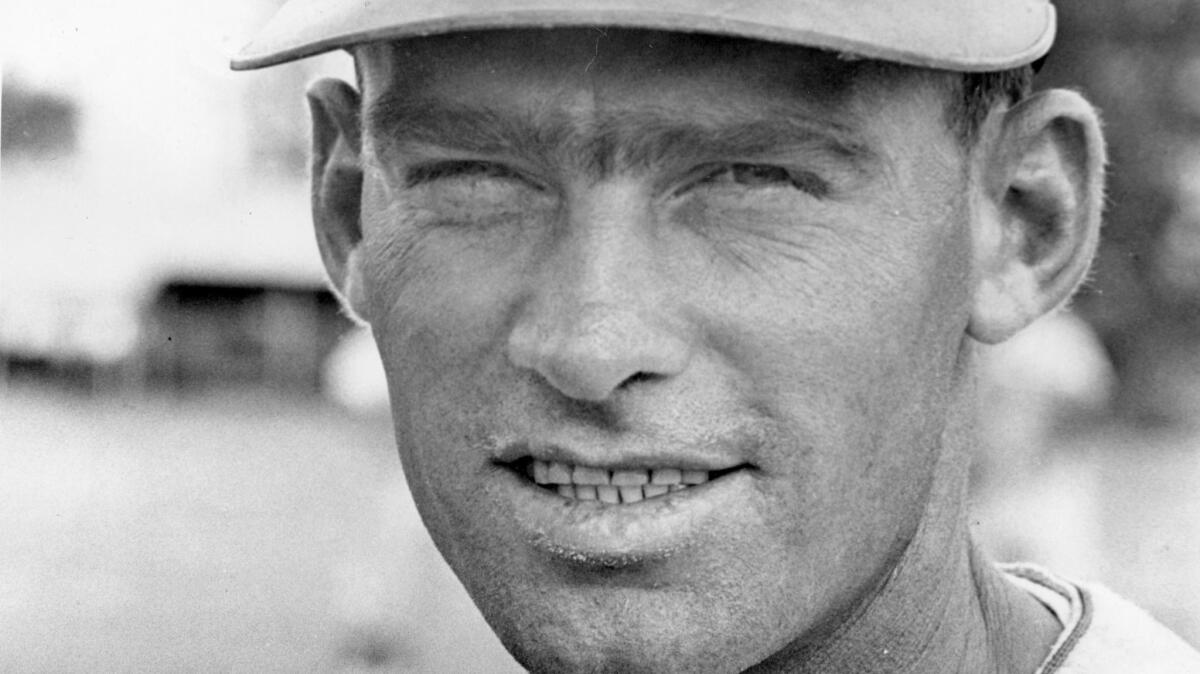Former Dodgers slugger Wally Moon, whose ‘Moon shots’ helped team reach three World Series, dies at 87

Wally Moon, the wiry outfielder with the old-school crew cut who helped take the Dodgers to the World Series three times and became a crowd favorite for his towering “Moon shots,” has died.
Moon, who became part of the Dodgers lineup shortly after the team moved west from Brooklyn, died Friday in Bryan, Texas. He was 87.
A lefty who had proved to be a steady hitter with decent power while with the St. Louis Cardinals, Moon was nonetheless coming off a down year when he was traded to the Dodgers in 1959. The Cardinals even tossed in a pitcher to make the deal work. For the Dodgers, coming off a seventh-place finish, it seemed an odd way to rebuild.
And there was the ballpark where the Dodgers then played: the cavernous Coliseum, a graveyard for left-handed batters.
It was a staggering 440 feet to the right-field fence. By contrast, the left-field bleachers were a friendly 251 feet from home plate — a chip shot for a decent player. To take advantage of the odd dimensions, the Dodgers stacked their lineup with righties.
“I really wasn’t sure how much I was going to get to play,” Moon told The Times in 2008.

After consulting with former teammate Stan Musial, generally regarded as one of the finest hitters in the game, Moon decided to adjust his swing and his stance at the plate so that he could drive the ball to left field. And to get it over the 42-foot screen that hung in front of the left-field bleachers, he learned to uppercut the ball.
The results were impressive. Hitting in a lineup with fearsome players such as Duke Snider, Gil Hodges and John Roseboro, Moon batted .302 and swatted 19 home runs, nine of them to left field. The most dramatic was a towering ninth-inning “Moon shot” to left field in a 2-2 game against the San Francisco Giants in 1959.
The walk-off home run helped carry the team to the World Series, where they knocked off the Chicago White Sox to win it all.
“It was unforgettable,” Moon said decades later. “I can still hear it, still feel it, still see it all these years.”
Wallace Wade Moon was born April 3, 1930, in Bay, Ark., a speck of a town surrounded by cotton fields. Moon said his father dropped out of school in eighth grade, and regretted the decision the rest of his life. Moon was raised with the expectation that he would go to college. When he graduated from high school and was offered a baseball contract, his father persuaded him to turn it down.
After earning a degree in education from Texas A&M, Moon finally signed with the Cardinals but with the stipulation that he would play only during the summer months until he finished his master’s degree. The money he made playing part time was set aside so that his younger sister could also go to college.
In 1954, Moon was rushed to the major leagues. He later calculated that he had played all of 17 games in the year before his major league debut and felt overwhelmed when the Cardinals traded away fan favorite Enos Slaughter to clear a spot in the lineup for him.
But hitting a home run in his first at-bat helped ease the jitters, and he went on to hit .304 on the year with 76 RBIs, enough to earn him National League Rookie of the Year honors. He spent five seasons in St. Louis before he was shipped to the Dodgers in exchange for Gino Cimoli, who — like Moon — was coming off a disappointing season.

It was a golden era for the Dodgers. After winning the World Series in 1955, the team repeated as major league champs in 1959, 1963 and 1965, riding the arms of Sandy Koufax and Don Drysdale, the bat of Tommy Davis and the base-running prowess of Maury Wills. The team moved into the newly built Dodger Stadium in 1962. But as the years went by, Moon was slowly pushed out of the starting lineup.
In 1965, he called it quits, ending a 12-year career during which he hit 142 home runs and was named to the all-star team three times. His last game in uniform was against the Minnesota Twins in Game 7 of the 1965 World Series. He never got off the bench.
By the end of the year, he’d sold his house in Encino and moved back to Arkansas with his wife and five children.
“The children were growing up, drugs were starting to come on the scene and I decided I didn’t want to raise my family in Southern California,” he explained to the Baltimore Sun in 1990. “My wife and I are both small-town people at heart.”
Moon moved the family to Siloam Springs, Ark., where the plains meet the Ozark Mountains. He took a job as the athletic director and baseball coach at John Brown University, a small private Christian college were he worked and taught for 15 years, aside from one year when he took a leave of absence to take over as the batting coach for the San Diego Padres. He later became manager and an owner of the San Antonio Dodgers, before retiring and moving to Bryan, Texas. In 2010 his autobiography, “Moon Shots: Reflections on a Baseball Life,” was published.
In 2008, when the Dodgers played an exhibition game against the Boston Red Sox in the Coliseum, Moon was invited back to a field where he had created so many memories.
Before the game, he was playfully asked whether he want to take batting practice with the team to see if he could launch one last “Moon shot.”
He chuckled.
“I haven’t picked up a bat in 30 years, but I’ll take a shot at it. I still play a lot of golf, so I might be able to get it there.
Moon’s wife, Bettye, died in 2016. He is survived by five children and seven grandchildren.

Start your day right
Sign up for Essential California for the L.A. Times biggest news, features and recommendations in your inbox six days a week.
You may occasionally receive promotional content from the Los Angeles Times.




